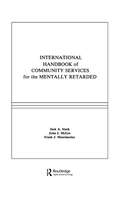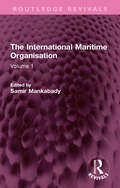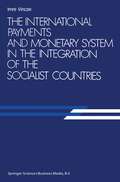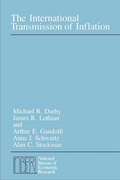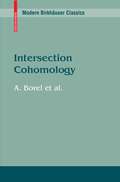- Table View
- List View
International Dimensions Of Land Reform
by John D MontgomeryLand reform became an international issue in the aftermath of World War II, when the United States planned to dispossess the Junker in Prussia and actually participated in major land redistribution programs in Japan, the Republic of China, and Korea. It became a canon of United States foreign policy in the Philippines, Thailand, and Iran, as
International Financial Reporting: A Comparative International Survey of Accounting Requirements and Practices in 30 Countries
by S. J. Gray L. G. Campbell J. C. ShawInternational Handbook of Community Services for the Mentally Retarded (School Psychology Series)
by J. A. Stark J. J. Mcgee F. J. MenolascinoThis handbook provides the reader with the applied knowledge essential for initiating, building, and continuing community service programs for the mentally retarded. Applied to specific populations, and to both urban and rural settings, the model also offers a blueprint for establishing successful service systems.
International Handbook of Community Services for the Mentally Retarded (School Psychology Series)
by Jack A. Stark, John J. McGee and Frank J. MenolascinoThis handbook provides the reader with the applied knowledge essential for initiating, building, and continuing community service programs for the mentally retarded. Applied to specific populations, and to both urban and rural settings, the model also offers a blueprint for establishing successful service systems.
The International Maritime Organisation: Volume 1 (Routledge Revivals)
by Samir MankabadyOriginally published in 1984, this book provides a survey of the shipping rules adopted under the auspices of the International Maritime Organisation (IMO) during the latter part of the 20th Century. Its scope is wide-ranging, and, since the measures adopted by the IMO cover a great variety of disciplines, the papers in this book are written with clarity and authority by a number of experts
The International Maritime Organisation: Volume 1 (Routledge Revivals)
Originally published in 1984, this book provides a survey of the shipping rules adopted under the auspices of the International Maritime Organisation (IMO) during the latter part of the 20th Century. Its scope is wide-ranging, and, since the measures adopted by the IMO cover a great variety of disciplines, the papers in this book are written with clarity and authority by a number of experts
International Money Flows and Currency Crises
by Istvan GyongyossyThe author had already become involved with the subject of this book when President Nixon suspended the convertibility of the dollar on August 15, 1971. This declaration was equivalent to an official admission of the previously evident failure of the inter national monetary system established in Bretton Woods after long and difficult negotiations. Although the real reasons for this failure are much deeper and more complex, the immediate cause was the tremendous outjlow of money from the United States to Europe and Japan. Never before had economic history recorded a currency movement of such magnitude, although during the periods preceding the devaluation of the French franc and the re valuation of the Deutsche Mark (Le. , by the end of 1968 and mostly in 1969), and particularly at the beginning of 1971, the in ternational flow of money grew to such huge proportions as to alm ost traumatize the economic and financial circles of developed capitalist countries. These economic and financial circles correctly foresaw that the ever growing and hardly controllable volume of currency flow could seriously endanger the already precarious balance of the international financial system and perhaps even upset it. This brief analysis, in contrast to many other predictions of cur rency developments, holds true for a longer period as well.
International Nuclear Nonproliferation System: Challenges and Choices
by John Simpson Anthony G. McGrewThe International Payments and Monetary System in the Integration of the Socialist Countries
by Imre VinczeEconomic cooperation between the CMEA countries is implemented according to the monetary and financial regulations worked out collectively. The regulations cover the organizational structure of international settlements; the choice of currency for settlements; the principles of international credit transactions ; the determination ofthe exchange rate of the currency used in international settlements to national currencies and to convertible currencies outside the CMEA; the principles and rules ofinternational exchange and transfers; mIes for the currency allotments of citizens (roles of international transfers for citizens). The regulations also contain provisions for international settlements and credit transactions which are concluded through an independent international bank or banks. These regulations, the instruments and institutions together, form the international payments and monetary system of the CMEA. * The financial and monetary regulations of the CMEA community were formed in several stages, depending on the prevailing· conditions and the targets to be attained. In the years between 1949 and 1963 the general form of economic cooperation and of international settlements was the bilateral clearing agreement. In the bilateral agreements which the Soviet Union concluded with the other CMEA countries the currency of settlements was the Soviet rouble. The prices applied in foreign trade were not the internal producer prices of the Soviet Union, but world market prices (main international market prices) expressed in roubles, with the he]p ofthe exchange rate ofthe Soviet rouble to the US dollar, as quoted in the Soviet Union.
The International Transmission of Inflation (National Bureau of Economic Research Monograph)
by Michael R. Darby James R. Lothian Arthur E. Gandolfi Anna J. SchwartzInflation became the dominant economic, social, and political problem of the industrialized West during the 1970s. This book is about how the inflation came to pass and what can be done about it. Certain to provoke controversy, it is a major source of new empirical information and theoretical conclusions concerning the causes of international inflation. The authors construct a consistent data base of information for eight countries and design a theoretically sound model to test and evaluate competing hypotheses incorporating the most recent theoretical developments. Additional chapters address an impressive variety of issues that complement and corroborate the core of the study. They answer such questions as these: Can countries conduct an independent monetary policy under fixed exchange rates? How closely tied are product prices across countries? How are disturbances transmitted across countries? The International Transmission of Inflation is an important contribution to international monetary economics in furnishing an invaluable empirical foundation for future investigation and discussion.
The International Transmission of Inflation (National Bureau of Economic Research Monograph)
by Michael R. Darby James R. Lothian Arthur E. Gandolfi Anna J. SchwartzInflation became the dominant economic, social, and political problem of the industrialized West during the 1970s. This book is about how the inflation came to pass and what can be done about it. Certain to provoke controversy, it is a major source of new empirical information and theoretical conclusions concerning the causes of international inflation. The authors construct a consistent data base of information for eight countries and design a theoretically sound model to test and evaluate competing hypotheses incorporating the most recent theoretical developments. Additional chapters address an impressive variety of issues that complement and corroborate the core of the study. They answer such questions as these: Can countries conduct an independent monetary policy under fixed exchange rates? How closely tied are product prices across countries? How are disturbances transmitted across countries? The International Transmission of Inflation is an important contribution to international monetary economics in furnishing an invaluable empirical foundation for future investigation and discussion.
The International Transmission of Inflation (National Bureau of Economic Research Monograph)
by Michael R. Darby James R. Lothian Arthur E. Gandolfi Anna J. SchwartzInflation became the dominant economic, social, and political problem of the industrialized West during the 1970s. This book is about how the inflation came to pass and what can be done about it. Certain to provoke controversy, it is a major source of new empirical information and theoretical conclusions concerning the causes of international inflation. The authors construct a consistent data base of information for eight countries and design a theoretically sound model to test and evaluate competing hypotheses incorporating the most recent theoretical developments. Additional chapters address an impressive variety of issues that complement and corroborate the core of the study. They answer such questions as these: Can countries conduct an independent monetary policy under fixed exchange rates? How closely tied are product prices across countries? How are disturbances transmitted across countries? The International Transmission of Inflation is an important contribution to international monetary economics in furnishing an invaluable empirical foundation for future investigation and discussion.
Interpolation Spaces and Allied Topics in Analysis: Proceedings of the Conference Held in Lund, Sweden, August 29 - September 1, 1983 (Lecture Notes in Mathematics #1070)
by M. Cwikel J. PeetreInterpretation and Extrapolation of Chemical and Biological Carcinogenicity Data to Establish Human Safety Standards: The Use of Short-Term Tests for Mutagenicity and Carcinogenicity in Chemical Hazard Evaluation (Current Issues in Toxicology)
by H. C. GriceThe International Life Sciences Institute (lLSI) is a scientific foundation wh ich addresses critical health and safety issues of national and international concern. ILSI promotes international cooperation by pro viding the mechanism for scientists from government, industry and universities to work together on cooperative programs to generate and disseminate scientific data. The members and trustees of the Institute believe that questions regarding health and safety are best resolved when scientists can ex amine and discuss issues, as an independent body, se~arate from the political pressures of individual countries and the economic concerns of individual companies. Frequently, meaningful assessment of the risk of a test substance is hindered by the inherent inconsistencies in the system. The development and refinement of methods and systems to evaluate the safety of chemicals have evolved in a rapid and largely unplanned fashion. Attempts to improve the system have largely been directed toward broad general concerns, with little attention being given to specific problems or issues. A failure to resolve these problems has frequently resulted in increased testing costs and complications in the assessment and extrapolation of the results. Publicity surrounding toxicologic issues has created chronic public apprehension about the ability of science and government to deal effectively with these problems. In response to these difficulties, ILSI has assembled highly qualified and renowned scientists from research institutes, universities, government and industry, with relevant scientific knowledge and expertise regarding the issues that complicate risk assessment procedures.
Intersection Cohomology (Modern Birkhäuser Classics Ser.)
by Armand BorelThis book is a publication in Swiss Seminars, a subseries of Progress in Mathematics. It is an expanded version of the notes from a seminar on intersection cohomology theory, which met at the University of Bern, Switzerland, in the spring of 1983. This volume supplies an introduction to the piecewise linear and sheaf-theoretic versions of that theory as developed by M. Goresky and R. MacPherson in Topology 19 (1980), and in Inventiones Mathematicae 72 (1983). Some familiarity with algebraic topology and sheaf theory is assumed.
Intersection Theory (Ergebnisse der Mathematik und ihrer Grenzgebiete. 3. Folge / A Series of Modern Surveys in Mathematics #2)
by W. FultonFrom the ancient origins of algebraic geometry in the solution of polynomial equations, through the triumphs of algebraic geometry during the last two cen turies, intersection theory has played a central role. Since its role in founda tional crises has been no less prominent, the lack of a complete modern treatise on intersection theory has been something of an embarrassment. The aim of this book is to develop the foundations of intersection theory, and to indicate the range of classical and modern applications. Although a comprehensive his tory of this vast subject is not attempted, we have tried to point out some of the striking early appearances of the ideas of intersection theory. Recent improvements in our understanding not only yield a stronger and more useful theory than previously available, but also make it possible to devel op the subject from the beginning with fewer prerequisites from algebra and algebraic geometry. It is hoped that the basic text can be read by one equipped with a first course in algebraic geometry, with occasional use of the two appen dices. Some of the examples, and a few of the later sections, require more spe cialized knowledge. The text is designed so that one who understands the con structions and grants the main theorems of the first six chapters can read other chapters separately. Frequent parenthetical references to previous sections are included for such readers. The summaries which begin each chapter should fa cilitate use as a reference.
The Intertrochanteric Osteotomy
by J. Aronson R. Bombelli R. Feinstein J. Holder E. Morscher M. E. Müller F. Pauwels J. Schatzker R. Schneider H. WagnerInterventions in the Acute Phase of Myocardial Infarction (Developments in Cardiovascular Medicine #41)
by E. NeilMoore JoelMorganrothIn the 1980's a primary focus for intense cardiovascular research is in the treatment of patients with acute myocardial infarction. Although the prevalence of this syndrome has been decreasing in the United States, still over 1.5 million patients develop myocardial infarction per year. There is about a 20% chance of a North American male developing myocardial in farction before the age of 65. The in-hospital mortality still remains at ap proximately 10070-15070 and advances in pharmacologic and device therapy have allowed for the intensification of research in the treatment of patients with acute myocardial infarction. The following manuscripts represent the collective efforts of academic in vestigators in the United States and abroad as well as members of the phar maceutical industry, and the Food and Drug Administration to address the issues involved in interventions in the acute phase of myocardial infarction. State-of-the-art papers addressing important topics are followed by discus sion sections which have allowed participants to express their own viewpoints leading to a consensus opinion. The first part of this Symposium addresses the models of experimental myocardial infarction followed by the important issue of how one defines myocardial infarction size. The latter is extremely important to be certain that endpoints of therapeutic or device interventions are objective and reproducible. A detailed description of the pharmacological interventions to reduce myocardial infarction size as well as newer devices to effect mechanical and electrical disorders provide an up-to-date summary of current opinion.
Intra-Arterial and Intracavitary Cancer Chemotherapy: Proceedings of the Conference on Intra-arterial and Intracavitary Chemotheraphy, San Diego, California, February 24–25, 1984 (Developments in Oncology #26)
by Stephen B. HowellProceedings of the Conference on Intra-arterial and Intracavitary Chemotherapy, San Diego, California, February 24-25, 1984
Intramolecular Diels-Alder and Alder Ene Reactions (Reactivity and Structure: Concepts in Organic Chemistry #18)
by Douglass F. TaberThe Diels-Alder reaction has long been a powerful tool in organic synthesis. In recent years, the Alder ene reaction has also achieved some prominence. From the beginning, it was apparent that the intramolecular variants of these reactions would be feasible. Many such have been reported, but the results are widely scattered in the chemical literature. This volume is an attempt to synthesize results observed to date, and to suggest directions for future development. One of the limiting factors in the application of the intramolecular Diels Alder reaction has been the development of methods for the preparation of the requisite trienes. The fIrst chapter of this volume summarizes methods for the preparation of dienes and dienophiles. Examples representative of every general approach to 1,3-dienes and to dienophilic functional group combinations have been included. There are two questions one might ask in considering the prospective cyclization of a given triene: what are the factors that govern the rate of cyclization? and, for cyclizations that lead to the creation of one or more new chiral centers, what are the factors that govern diastereoselectivity? These questions are addressed in Chapter Two. The third chapter is devoted to the all-carbon intramolecular Alder ene reaction. The tables in that chapter summarize all examples that could be found in the literature through 1981, with several additional examples from 1982. Leading references to heterocyclic ene reactions are also included in this chapter.
Intravascular Infusion Systems: Principles and Practice
by Robert K. AusmanThis book has been written for use by health professionals, typically physicians, nurses, and pharmacists, who have a constant relationship with intravascular infusions. It is intended to provide information where appropriate and guidance when possible for the safe and effective use of parenteral fluids. For several years medical practitioners viewed 'i.v. fluids' rather casu ally. In as much as the solutions themselves seemed innocuous, these medications did not enjoy the respect given to more potent pharmaceuti cals. Intravenous fluid systems were commodities; purchase and use decisions for whole hospitals were placed in the domain of business office personnel. Any tendency toward cessation of 'in hospital manufacture' of solutions was driven by the adverse economics of costly equipment replacement rather than a desire to improve the quality of the product being administered to the patient. An event in 1971 which changed this environment involved an epidemic of patient infections which were related to a specific solution system. Almost immediately there was an enhanced involvement of health care people who assumed responsibility for i.v. fluids and their use. This intensity of interest has not diminished. A few years ago publication of this book would not have been possible because there was no audience for it. No one was interested. Now there are many people who want to know and want to become involved. It is my hope those who read this book will not be disappointed.


